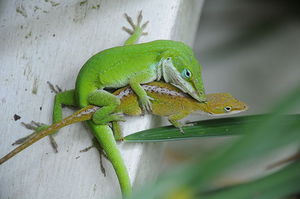Lizard Reproduction
| This article has been peer reviewed but is awaiting expert review. If you would like to help with this, please see more information about expert reviewing. |

Introduction
Lizards have breeding seasons determined by cycles of photoperiod, temperature (most common), rainfall, and food availability. A corresponding fluctuation can be seen in male lizards and testicular size. Male lizards may also undergo behavioural changes during breeding season and become more territorial and aggressive.
Lizard reproductive strategies vary; they may be:
- oviparous - laying eggs (most lizards)
- ovoviviparous - the eggs are retained within the female until birth of live young (all monitors, most iguanids, water dragons, all geckos, most chameleons)
- viviparous - live-bearing, with a placental type of circulatory connection (blue-tongued skinks, shingle-backed skink, prehensile-tailed skink, Jackson's chameleon)
- parthenogenic - asexual reproduction found in lizards such as certain Lacerta spp. and whiptail lizards (Aspidocelis [Cnemidophorus] spp.) consisting entirely of females. Although they reproduce asexually, these females still show courting and pseudocopulation.
Parthenogenesis has been reported in about 30 species of lizards.
Sexual Maturity
Sexual maturity in reptiles is mainly determined by size. Standard ages of sexual maturity found in the literature usually apply to free-ranging animals. However in captiivty, environmental conditions, care and most importantly diet vary dramatically, resulting in reptiles becoming sexually mature at very different ages. As a reference and rough generality, small lizards take 1 to 2 years and large lizards 3 to 4 years to reach sexual maturity.
Temperature-Dependent Sex Determination
A few species of lizards, such as the leopard gecko (Eublepharis macularius) have temperature-dependent sex determination where the sex of the developing fetus is determined by the temperature at which the eggs are incubated. The exact temperatures are species dependent; however the shift from one sex to the other is not absolute. A range of temperatures exists at which both sexes are produced at varying proportions and therefore most incubators used by breeders are not accurate.
References
- Mader, D.R. (2005). Reptile Medicine and Surgery. Saunders. pp. 1264. ISBN 072169327X